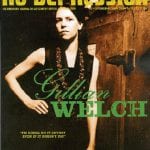Positively 4th Street: The Lives & Times Of Joan Baez, Bob Dylan, Mimi Baez Farina And Richard Farina
Sales of guitars in the U.S. topped 600,000 in 1963, nearly double the year before. More than two hundred folk albums were released that year, Joan Baez In Concert was a Top Ten seller, and the surprise hit single of the summer, reaching #2 on the charts, was “Blowin’ In The Wind” by Peter, Paul & Mary. That summer the Newport Folk Festival made a triumphant return after a two-year hiatus, more than 70 acts playing to overflow crowds, and folk provided the soundtrack when 250,000 people gathered in D.C. for the March on Washington in August.
“Hootenanny” became unlikely household currency that year, traded not only on album covers, but television (ABC’s “Hootenanny” debuted that year), theater marquees (“Hootenanny Hoot” starred one Judy Henske, and featured Johnny Cash), radio formats (“100% Hootenanny”), and Madison Avenue. The folk revival was at its apogee, as both a commercial and a cultural force, Joan Baez its reigning queen, Bob Dylan the new darling prince.
David Hadju’s fine Positively 4th Street returns us to the days when folk was hip, and as popular as any music in America. But it’s no nostalgia trip. Hadju’s principals, Joan and Mimi Baez, Richard Farina, and Bob Dylan, were young and ambitious but hardly innocent (OK, Mimi was merely young). Opportunism, pretension, self-absorption and self-promotion were as much the order of the day as commitment to folk purity and political agendas, especially for the boys.
The high tide was brief, as pop moments are. The Beatles broke in early 1964, altering the equation; whatever role they may have played in reawakening Dylan’s inner-Elston Gunn, he was soon to find more inspiration in the Symbolists, amphetamines and the electric guitar than in Harry Smith’s Anthology or Joan’s bedroom in Carmel.
By the time of his infamous Newport 1965 performance, the iconic “We Shall Overcome” finale of the ’63 festival may as well have been ancient history for Dylan, who was on the brink of history, and for the folk revival too, which was quickly becoming history.
Despite some perverse career moves along the way, and though his muse visits infrequently these days, forty years later Dylan is the only one of Hadju’s protagonists who still matters as a living artist. Two other recent titles go beyond the folk moment to address the full scope of the career, how the reputation was won, and why it’s still his to lose.
With Down The Highway, David Sounes claims to have written the “major biography that conveys the full grandeur of Bob Dylan’s artistic achievement, and also reveals the true life of this fascinating and elusive man…based on painstaking new research.”
The truth is Sounes really has nothing new and little of interest to say about the achievement, and it takes a certain suspension of suspicion to imagine that one can reveal “the true life” of a figure as elusive and layered in tale as Dylan. He himself has been an unreliable and increasingly inscrutable source since his first days in New York. His friends and collaborators over the years have offered inconsistent testimony, some key players can’t (Grossman) or won’t (Sara) testify at all, and his various biographers can’t even agree on basic facts (compare reports of his stint at the Gilded Garter, or the number of his progeny).
The question remains: How enriched are we by the fruits of Sounes’ “new research”? Does a precise accounting of Dylan’s “property portfolio,” or the revelation that his secret but rumored union with Carolyn Dennis was sanctified on June 4, 1986, alter our understanding of the artist?
If the “full grandeur,” as well as the grand failures, of the artistic achievement is what you’re after (and why else does anyone care about Dylan?), shelve Sounes and turn to Clinton Heylin’s Bob Dylan: Behind The Shades Revisited, a revised update of his 1991 biography. Heylin styles himself the “world’s leading Bob Dylan scholar,” and his tone is every bit as arrogant as that suggests. Still, he has obviously spent the countless hours digesting Dylan’s recorded legacy, official releases, studio outtakes and concert tapes required to earn the crown, much to our profit.
He offers the deepest critique of the recording career (though much of what’s here is more or less lifted from his Bob Dylan: The Recording Sessions, an essential reference for the armchair Dylanologist), and the most detailed account of the myriad tours, that one could hope for in one volume. As the biographer of a living legend, Heylin is also keen to the “myth-building at stake” all around, and the skepticism he brings to the project ought to be a lesson to those with pretensions toward uncovering “the true life” of an enigmatic moving target.




